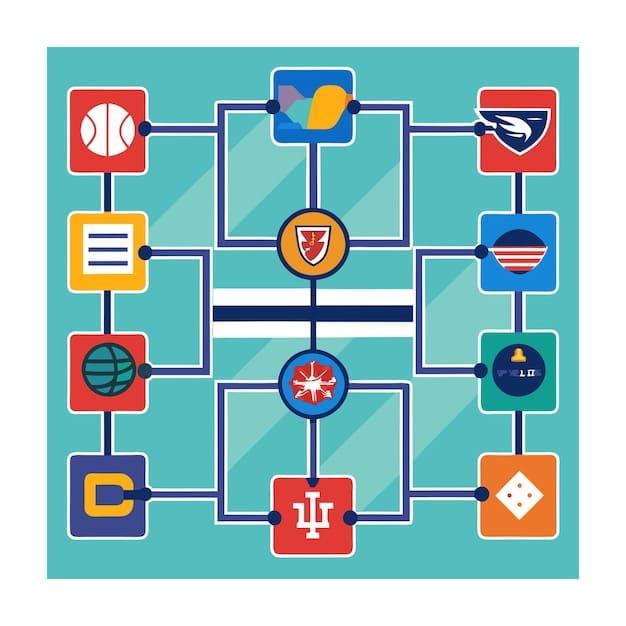Decoding EPL Tactics: A US Fan’s Guide to Positional Play

Decoding Premier League Tactics: How US Fans Can Understand Positional Play and Pressing Strategies involves breaking down the complex formations, player movements, and strategic approaches employed by top EPL teams, tailored for American fans to enhance their viewing experience.
The Premier League, with its global appeal, has captured the hearts of many American soccer fans. However, understanding the intricacies of tactical battles on the pitch can be challenging. Decoding Premier League Tactics: How US Fans Can Understand Positional Play and Pressing Strategies aims to bridge that gap, providing insights into positional play and pressing strategies that define the modern game.
Understanding Positional Play in the Premier League
Positional play, or *juego de posición*, is a tactical approach emphasizing maintaining a specific spatial arrangement to control the game. This section delves into how Premier League teams utilize positional play to dominate possession and create scoring opportunities.
Premier League clubs have increasingly adopted positional play, inspired by its effectiveness in leagues across Europe. Understanding its core principles helps in appreciating the nuances of EPL matches.
Key Principles of Positional Play
Positional play revolves around several fundamental principles that guide player movement and decision-making. These principles ensure a cohesive and effective team performance.
- Maintaining Spatial Balance: Keeping players spread out across the field to create passing lanes and prevent the opposition from easily pressing.
- Creating Numerical Superiority: Overloading specific areas of the pitch to outnumber opponents and win possession.
- Dynamic Movement: Players constantly rotating positions to disrupt the opposition’s defensive structure and find open spaces.
Examples of Positional Play in Premier League Teams
Several Premier League teams have become known for their effective use of positional play, each with their own unique interpretations of the tactic.
Manchester City, under Pep Guardiola, is a prime example. Their emphasis on short, quick passes and constant movement exemplifies the best of positional play.

Liverpool, under Jürgen Klopp, also utilizes positional play, but with a more direct and aggressive approach. Their full-backs push high, and their forwards make incisive runs to exploit space.
In conclusion, positional play is a critical element of modern Premier League tactics, allowing teams to control the game and create scoring chances. Understanding its principles can greatly enhance a US fan’s appreciation of the EPL.
Analyzing Pressing Strategies in the EPL
Pressing is a defensive strategy aimed at winning back possession high up the pitch, often forcing errors from the opposition. Let’s break down how Premier League teams use pressing to disrupt opponents.
Pressing has become an integral part of Premier League football, with teams employing various forms of pressing to stifle their rivals and create attacking opportunities.
Types of Pressing
There are different types of pressing strategies, each varying in intensity and triggers. Understanding these variations is crucial for analyzing how teams defend in the Premier League.
- High Press: Pressing high up the pitch, often in the opponent’s defensive third, to win back possession near the goal.
- Mid-Block: Defending in a compact shape in the middle third of the pitch, aiming to intercept passes and prevent the opposition from progressing.
- Low Block: Sitting deep in their own half, inviting the opposition to attack, and then countering quickly.
Teams Known for Pressing
Tottenham Hotspur, under managers like Mauricio Pochettino and Antonio Conte, has been known for their high-intensity pressing, aiming to win the ball back quickly and launch counter-attacks.
Liverpool, under Jürgen Klopp, also utilizes a high press, often referred to as “gegenpressing,” to swarm the opposition and regain possession immediately after losing it.
In summary, pressing is a fundamental defensive tactic in the Premier League, with teams employing various strategies to win back possession and create attacking opportunities.
The Role of Formations in Premier League Tactics
Formations are the foundational structure upon which tactical strategies are built. This section examines common formations in the Premier League and their impact on gameplay.
Formations dictate how players are positioned on the field and influence both attacking and defensive strategies. Being familiar with common Premier League formations can help understand teams’ tactical approaches.
Common Formations
Several formations are frequently used in the Premier League, each with its own strengths and weaknesses.
- 4-3-3: A balanced formation with a strong midfield and attacking focus. This formation allows for dynamic attacking play and solid defensive coverage.
- 4-2-3-1: A versatile formation that offers both defensive stability and attacking threat. The two holding midfielders provide protection to the back four, while the attacking midfielders support the lone striker.
- 3-5-2: A formation that emphasizes attacking through the wings with wing-backs and maintaining a solid defensive base with three center-backs.

Adapting Formations
Premier League teams often adapt their formations based on the opponent and the game situation. These adaptations can involve subtle tweaks or significant changes in player positioning.
Managers like Thomas Tuchel and Pep Guardiola are known for their tactical flexibility, often changing formations mid-game to exploit the opposition’s weaknesses.
In conclusion, understanding formations is crucial for analyzing Premier League tactics, as they provide the framework for how teams organize themselves on the pitch.
Analyzing Player Roles and Responsibilities
In addition to formations and strategies, individual player roles significantly influence how a team executes its tactics. This section explores the roles of key players in Premier League teams.
Each player on a Premier League team has specific responsibilities that contribute to the overall tactical plan. Understanding these roles enhances the ability to analyze team performance.
Key Player Roles
Certain player roles are common across various Premier League teams, including:
- Holding Midfielder: Providing defensive cover in front of the back four and dictating the tempo of the game.
- Playmaking Midfielder: Creating chances with through balls, crosses, and set-piece deliveries.
- Wingers/Wide Forwards: Stretching the play, taking on defenders, and delivering crosses into the box.
Specific Examples
For example, N’Golo Kanté, when he played for Chelsea, excelled as a holding midfielder, providing defensive solidity and breaking up opposition attacks.
Kevin De Bruyne of Manchester City is a prime example of a playmaking midfielder, known for his incredible passing range and vision.
In summary, understanding player roles and responsibilities is essential for a complete analysis of Premier League tactics, as it highlights how individual contributions fit into the broader team strategy.
How Managers Influence Premier League Tactics
Managers play a pivotal role in shaping Premier League tactics. Their philosophies, training methods, and in-game decisions have a significant impact on how their teams perform.
The tactical approach of a Premier League team is largely determined by the manager’s vision. Studying how managers influence tactics can provide valuable insights into team performance.
Tactical Philosophies
Different managers have different tactical philosophies, which dictate their preferred style of play. Examples include:
- Possession-based Football: Emphasizing keeping the ball and controlling the game through short, quick passes.
- Counter-attacking Football: Absorbing pressure and then launching quick attacks to exploit the opposition’s exposed defense.
- High-pressing Football: Winning back possession high up the pitch to create attacking opportunities.
Examples of Managerial Influence
Pep Guardiola’s influence on Manchester City is evident in their possession-based style of play, which has led to numerous league titles.
Jürgen Klopp’s impact on Liverpool is apparent in their high-pressing approach, which has transformed the team into one of Europe’s most formidable sides.
In conclusion, managers are the architects of Premier League tactics, shaping their teams’ style of play and guiding them to success through their tactical decisions.
How Data Analytics is Changing EPL Tactics
Data analytics has revolutionized modern football, providing teams with valuable insights into player performance, opposition weaknesses, and tactical effectiveness. This section breaks down how data analytics is influencing Premier League tactics.
Data analytics is transforming how Premier League teams approach the game, offering a deeper understanding of performance and strategy. Embracing data-driven insights has become critical for competitive success.
Key Metrics
Various key metrics are used in data analytics to assess player and team performance, including:
- Expected Goals (xG): Measuring the quality of chances created and conceded.
- Pass Completion Rate: Evaluating the accuracy of passing and ball retention.
- Pressing Intensity: Quantifying the aggressiveness and effectiveness of pressing.
Applications of Data Analytics
Premier League teams use data analytics to inform various aspects of their operation, such as:
Scouting and recruitment, identifying players who fit their tactical system and have the potential to improve the team.
Training and match preparation, optimizing training sessions and developing game plans based on data-driven insights.
In-game decision-making, making tactical adjustments based on real-time data analysis.
In summary, data analytics is reshaping the landscape of Premier League tactics, providing teams with a competitive edge through data-driven decision-making.
| Key Concept | Brief Description |
|---|---|
| ⚽ Positional Play | Maintaining spatial arrangement to control the game. |
| 🛡️ Pressing | Winning back possession high up the pitch. |
| 📐 Formations | Team structure affecting tactics. |
| 📊 Data Analytics | Using metrics to inform tactics. |
Frequently Asked Questions
▼
Positional play involves maintaining specific spatial arrangements to control the game, create passing lanes, and prevent the opposition from easily pressing, ensuring cohesive team performance.
▼
Premier League teams utilize pressing to win back possession high up the pitch, force errors, and create attacking opportunities. High press, mid-block, and low block are commonly employed.
▼
Common formations include 4-3-3, offering balanced attack and defense; 4-2-3-1, versatile with defensive stability; and 3-5-2, emphasizing wing play and a solid defensive base.
▼
Managers shape tactics through their tactical philosophies, training methods, and in-game decisions. Their approaches, such as possession-based or high-pressing, significantly impact team performance.
▼
Data analytics provides valuable insights into player performance, tactical effectiveness, and opposition weaknesses. Teams use key metrics like xG and pass completion rate to inform decisions.
Conclusion
Understanding Premier League tactics, from positional play to pressing strategies and the influence of data analytics, enriches the viewing experience for US fans. By grasping these concepts, fans can appreciate the strategic depth and complexity of the beautiful game at its highest level.





